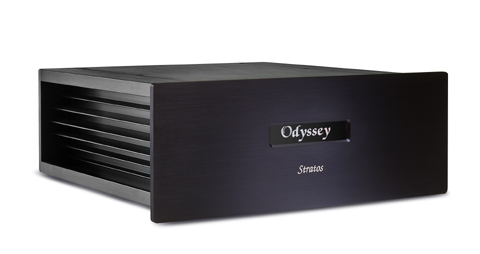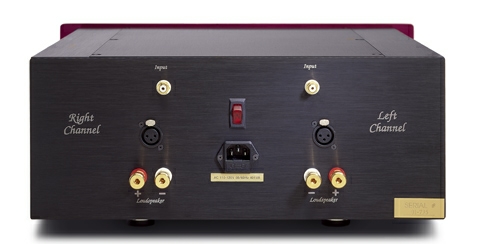Odyssey Design Labs Stratos 150 Stereo Amplifier
|
|
 |
| Sweet Dreams Are Made Of This | |
|
Clement Perry |
|
|
April 1999 |
 Specifications
Specifications
Type: solid state basic amplifier
Rated Power: 150 wpc/8ohms-260wpc/4ohms
Input impedance:47K
Inputs: Neutrik XLR & Coax
Output Class: A/AB
Frequency Range: 20hz-40khz
Dimension: 19 × 7 × 18
Memory: 64,000 mf
Current Delivery: 45 Amps
Weight: 52 lbs.
Price: $1,295
Serial #: 9806025
Address: 8 Matthews Drive, Suite 3
East Haddam, CT 06423
![]() Odyssey Design Labs, U.S. distributor of Symphonic line Products, recently started production of an all-new line of affordable products. The often-abused word “affordable” may be misleading because it seems to imply compromises every time. However, Odyssey’s management has stated to me in no uncertain terms: “The mission of Odyssey Design Labs, Inc., is to provide products at a level of quality, performance, and price that’s identified as one the best values in the high-end audio market.”
Odyssey Design Labs, U.S. distributor of Symphonic line Products, recently started production of an all-new line of affordable products. The often-abused word “affordable” may be misleading because it seems to imply compromises every time. However, Odyssey’s management has stated to me in no uncertain terms: “The mission of Odyssey Design Labs, Inc., is to provide products at a level of quality, performance, and price that’s identified as one the best values in the high-end audio market.”
As a direct descendant of the mighty $36,000 Kraft 400 Mono’s, I’m under the impression this amp has a lot of blue blood flowing through it’s $1,295 silicone heart. More importantly, after only a brief stint spent listening, I discovered it possessed the “this is some amp” look and feel usually reserved for the bigger ticket items. My first exposure was at the home of SCE Audio’s designer (Harmonic Recovery System), John Solicito. I was immediately impressed with this amp’s demeanor. After listening more in the Stratos/HRS/Custom House room at HiFi 98 in L.A., I requested a review for StereoTimes. Finally, in full production (delayed due to upgrades), I have received the latest review sample and will provide you with the results of my evaluation over the last six months.

The Odyssey Stratos 150 amplifier, as stated, is derived from the German amplifier lineage of Symphonic Line. Compared directly to the $5,800 Clayton M-70 mono’s, as well as the $16,000 Lamm M1.1 mono’s. I’ve concluded that the Stratos is a serious amplifier. Definitely not in the same league as the Lamm M11.1 amplifiers, but it comes damn close to matching the Clayton, (falling behind slightly to the Clayton’s wonderful top end and superior inner detail). Probable budget shoppers as well as big money spenders could very well regard the Stratos as the reference budget amplifier at its price. Here’s why.
The look and styling of the Stratos are very similar to those of many high-priced amps. The circuitry is designed by a German company, Symphonic Line. Its finely brushed aluminum faceplate and chassis are, to this reviewer, quite attractive, as is the backlit laser-engraved logo. The heat sinks are massive, resembling their more expensive relative, the Kraft 250 monos. Turning the Stratos around for inspection revealed more expensive features: equipped to handle both single-ended and XLR balanced inputs, its big, sturdy gold-plated connectors are standard, a significant plus for an amp at its asking price.
The Stratos is no featherweight either, weighing in at a substantial 52 pounds. The internal build integrity of the Stratos is superb, employing Wima caps, metal film resistors, and ALPS Potentiometers, while all internal wiring is Custom House’s Benchmark Reference cable.
All Odyssey Design Labs products are manufactured by Goguen Industries, a world-class electronics manufacturing facility that operates under ISO 9001 standards. I was informed that this level of operation is the most comprehensive standard of quality assurance a company can achieve. My review sample came in red! A burnished cherry red to boot. Odyssey states a simple strategy, “We offer multiple combinations in colors because we feel they have a better WAF appeal. We have expanded your choices beyond just standard silver and black. What colors, you ask? How are these flavors for the ladies with a taste for something sweet: Simply Red, Blue Velvet, and Green River? How can one argue that? Well, it certainly sparked much debate, with the vote split down the middle. Ten hated it while another ten gave it “two snaps and a circle!” Overall, I thought of it as innovative and a step in the right direction (albeit with a WAF appeal). An object that’s sure gonna bring up tête-à-tête. Shall we now discuss its sonic performance?
Listening to this amp was a treat. The Stratos has a neutral sound quality I would put oh so slightly on the dark side of neutral. A “cool,” sounding amplifier with just the right amount of detail to give it life. This balance was impressive right from the get-go. My preliminary notes read: very detailed, yet not too intrusive or forward sounding. Its sense of focus and image stability was very good, lending greater insight to soundstage layering and depth. The best way to describe the Stratos’ overall sonic makeup, I would have to say, in a word, “relaxed.” It handles, almost nonchalantly, dynamic extremes —both micro and macro —with a sense of ease that really makes this amp superb.
Especially important is the heart and soul reproduction of the midrange. To me, the merit of any amplifier should be immediately apparent by the way it handles the human voice. The Kathleen Battle/Wynton Marsalis CD, entitled Barock Duett (Sony SK 46672), displayed especially good tonal balance between the trumpet and soprano voice. The Stratos’s ability to keep Kathleen’s voice distinct, clear, and natural while grasping Wynton’s communicative spirit, simultaneously, proved very impressive. It didn’t stop there. Sade’s Love Deluxe (Epic EK53178) and Billie Holiday’s Lady In Satin (Columbia CK40247) demonstrated the Stratos’ neutrality through a variety of harmonic illustrations. Never did the Stratos lose touch with the recording venue in Holiday’s hauntingly vivid “I’m A Fool To Want You.”
Even when playing loud with peaks rising to around 110dB, the Stratos 150 weaved through complex chords, dynamic passages, and demanding bass tracks with impressive finesse. In addition, for any amplifier to quiet itself in silent passages as swiftly as this amp did is as important as how well it handles the rough and tumble. Still not as convincingly as the Lamm 1.1’s (these amps seem to swell up with power, strength, and dynamics), but providing run for the money against the Clayton M-70’s. Furthermore, not everything could be considered “just right” when concentrating on the upper registers, namely the upper treble region.
From about 3kHz to 10kHz, the Stratos was not as sweet or forgiving as the hybrid Lamms (employing a single 6922). This amp simply excels in sweetness, and I don’t mean in the euphoric sense of the word. And hell, it just may simply be the nature of the Stratos’ all-silicone heart that I was even able to detect, on certain CDs, an ever-so-slight silvery treble in the first place. Nothing to scream bloody murder about, but still noticeable. Of course, I hear virtually this same effect in the treble region on every solid-state amp I’ve auditioned. My solid-state references are the Balanced Audio VK1000 monos, along with the Lamm M1.1s and the latest Spectral amp, which I’ve heard at length at Harry Pearson’s Sea Cliff pad. For me, these suffer the least in this area. Note: I’ve listened to Mike Silverton’s 33rd’s (reviewed in this issue) and Arnie Balgavis’ Krell 250c monos, both of which are reference state-of-the-art rigs. Keeping these systems in mind, along with the price of the Stratos, there isn’t much to indict the Stratos for.
Listening to the Reference Recording Dallas Wind Symphony’s Fiesta (RR-38CD), I found where the Strato’s strengths were brought to light. A few seconds into the percussive “Prelude and Aztec Dance,” a thunderous low-frequency boom from a huge tympani drum literally shook my trousers. I could easily hear the mallet striking the skin, right before sending the sonic shock wave through my body. Here, in the sonic depths of bass, is where transistors have always seemed to have the edge against their tube counterparts. (My single-ended 50-watt KR VT800 doesn’t provide this sense of power and control in the bass. They do, however, sound more real, rendering plucked bass notes. Still, I felt an incredible sense of control in the lower registers, a sheer power that I miss with my 50-watt tube amps.. The Stratos served as a rude awakening here.
Of course, the “get down boogie oogie oogie” 96dB sensitivity of the VR-6’s must have helped in creating such dynamic interpretation. I think this amp could mate well with a variety of speaker systems, whether dynamic, planar, or electrostatic. Its conservative power rating of 150 watts per channel drove the Avance 980 superbly (see review elsewhere) as well as the Phantom 5.2’s. Excessive sibilance or treble on commercial CDs will not be concealed by this amplifier, a byproduct of its excellent transparency, despite a cool-sounding demeanor. Therefore, thorough and careful listening sessions with your local dealer will be required to find the perfect speaker and amplifier combination.
Overall, I thoroughly enjoyed my time with the Stratos 150, and I think you will too, especially when paired with the right speaker. In my opinion, if you’re looking for a great amplifier selling for less than $3,000, you owe it to yourself to audition this one, sweetheart of an amplifier.
![]()
Don’t forget to bookmark us! (CTRL-SHFT-D)
Stereo Times Masthead
Publisher/Founder
Clement Perry
Editor
Dave Thomas
Senior Editors
Frank Alles, Mike Girardi, Russell Lichter, Terry London, Moreno Mitchell, Paul Szabady, Bill Wells, Mike Wright, and Stephen Yan,
Current Contributors
David Abramson, Tim Barrall, Dave Allison, Ron Cook, Lewis Dardick, John Hoffman, Dan Secula, Don Shaulis, Greg Simmons, Eric Teh, Greg Voth, Richard Willie, Ed Van Winkle, Rob Dockery, Richard Doron, and Daveed Turek
Site Management Clement Perry
Ad Designer: Martin Perry





Be the first to comment on: Odyssey Design Labs Stratos 150 Stereo Amplifier